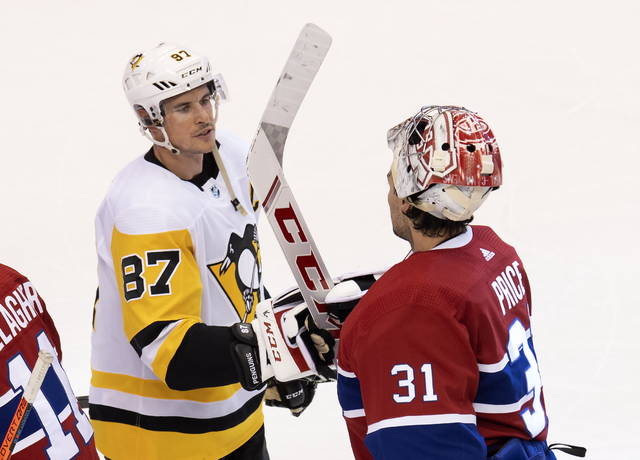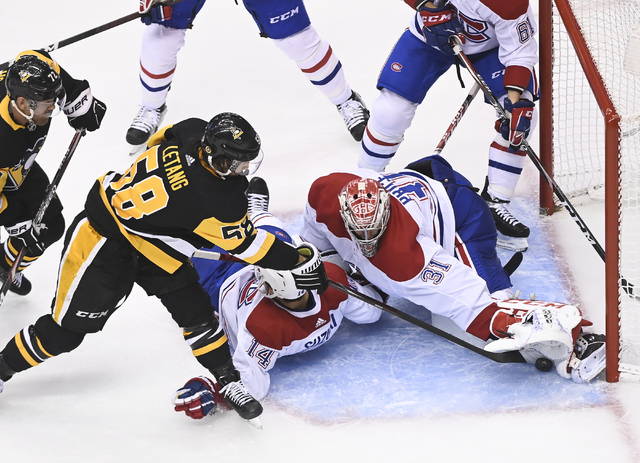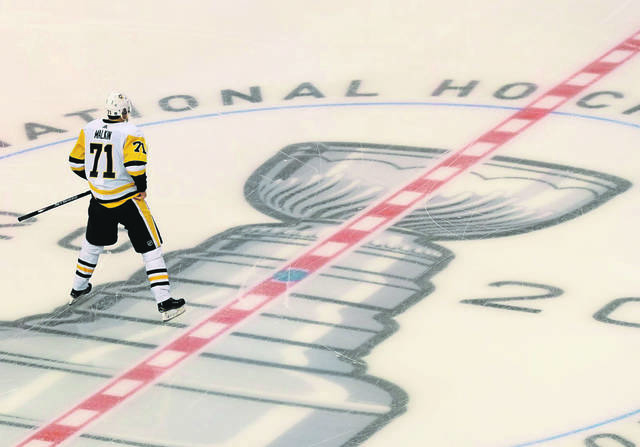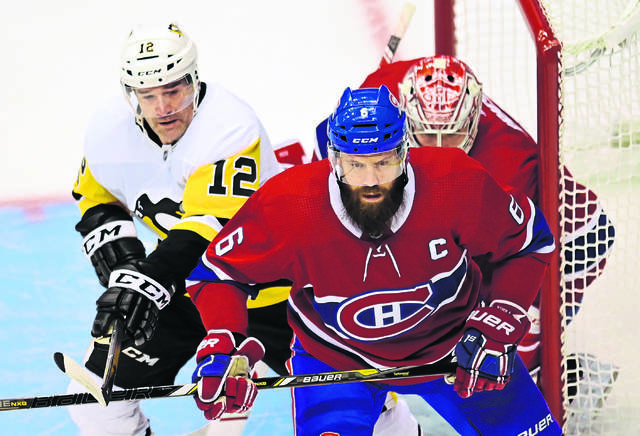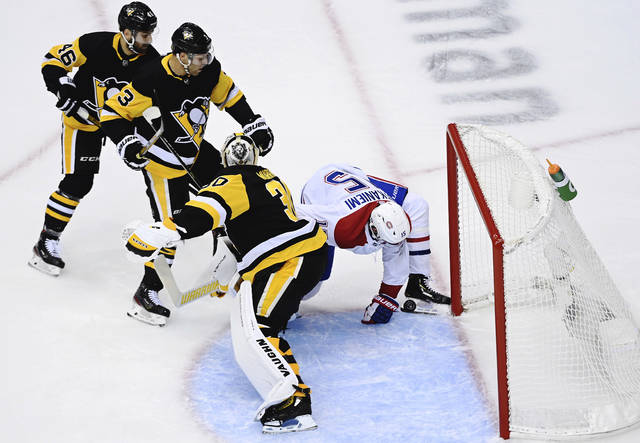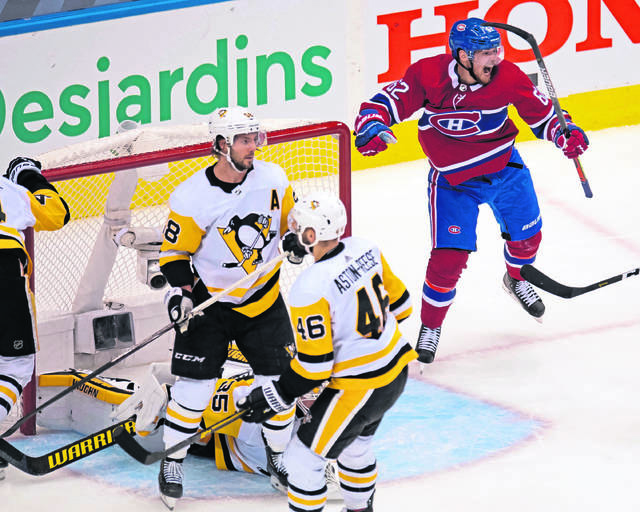What went wrong for Penguins against the Canadiens?
Mike Sullivan was relieved.
On March 10, in the aftermath of a tidy 5-2 road win against the New Jersey Devils, the Penguins coach stood outside the visiting dressing room of the Prudential Center in downtown Newark, N.J., and offered body language that suggested he finally resolved a great conundrum.
Struggling in their previous 10 games, the Penguins lost eight of those contests and infrequently looked at ease in the two they won. Add in the fact they were still working in some new players acquired via trade in late February, and the Penguins very much were a team in flux.
But that night in Newark, the Penguins played under their terms for nearly 60 minutes, albeit against an admittedly underwhelming Devils team.
It was the first time they could claim such an achievement in many weeks.
“That was one of the more complete games that we played in a while,” Sullivan beamed. “All four lines were going. The defensemen competed out there. We played the game the right way.”
The Penguins, retooled in the previous offseason to be a deeper team that attacked the opposition with speed and sound puck management, looked normal again.
Of course, that was the last time anything would resemble normal for them for the next four months.
Two days later, the NHL went into hiatus because of the coronavirus pandemic, and whatever momentum the Penguins or the NHL’s 30 other teams had harnessed came to a halt.
Fast forward to August and the Penguins’ season came to an abrupt halt once again, this time because of the Montreal Canadiens, who beat the Penguins, 3-1, in their best-of-five qualifying round series at Toronto’s Scotiabank Arena.
Whatever successes or flaws the Penguins possessed in mid-March bore little impact on their feeble showing in early August. After their 2-0 loss to the Canadiens in Game 4 on Friday, the Penguins were hesitant to draw any connection to their disrupted regular season and their unappetizing postseason.
“I don’t think you can associate what just happened (in the postseason) to the regular season,” defenseman Kris Letang said via video conference from Toronto. “The break that we just witnessed was longer than an offseason. I thought guys prepared themselves well, but when the puck dropped, I think we faced a well-balanced team with a great goaltender that played better than us. You have to evaluate the season and the playoffs (as) two different things.”
With that, here’s a look at what went wrong for the Penguins in four games over seven days.
1. Goaltending
It’s not an insult to Tristan Jarry or Matt Murray to say the 12th-seeded Canadiens had the better goaltending this series.
It’s more a confirmation Carey Price is still a master of his craft.
Rarely during the series did Price look fazed by the Penguins’ skilled attack. Granted, there were rare occasions where that skilled attack posed a sustained threat to Price, particularly when Penguins forward Conor Sheary failed to even hit the net on a penalty shot in the third period of Game 1, but at no time did Price look uncertain of himself.
Had the Penguins played the 11th-seeded New York Rangers, who propped up the husk of Henrik Lundqvist in net for two games against the Carolina Hurricanes, the Penguins probably would have advanced. Instead, they got the inferior Canadiens and the superior Price.
Perhaps if the qualifying round was a best-of-seven series instead of a best-of-five, the Penguins would have had had enough time to mount a more potent attack or could have broken Price down. But this was the hand they were dealt.
Jarry and Murray were adequate in this series. And Murray was even the better goaltender in Game 2, a 3-1 win. But over the series, there was enough incremental space between Price and his Penguins counterparts to create a chasm.
2. Power play
One of the few legit carryovers from the regular season to the postseason was the Penguins’ sputtering power play.
Much like the Penguins from October through March, the Penguins in August had moments where their power play looked dangerous, particularly in Game 3, but had plenty of other instances where they looked like they couldn’t spell “power play,” even if they were spotted the two “Ps.”
And it wasn’t just that the power play didn’t produce in bulk as much as it didn’t come through in vital junctures.
In Game 1, with the Canadiens’ fantastic defensive center Philip Danault in the penalty box early in overtime, the Penguins had a power-play chance on fairly clean ice but failed to score, only to yield a goal later in the period. And during the late stages of Game 3, they were afforded a chance with the man advantage while trailing by a goal. Working on choppy ice, they could only get one shot on net.
The power play could have been a dominant advantage for the Penguins. Instead, it was mostly inert, going 3 for 17 (17.7%).
3. Depth up front
The return of a healthy Jake Guentzel, sidelined for the remainder of the regular season because of a devastating right shoulder injury in December, had a trickle-down effect on the Penguins depth. With Guentzel back, Jason Zucker was bumped to the second line, and Patrick Marleau found himself on the third line.
On paper, the Penguins were one of the deepest teams in the postseason. In reality, they only had three lines that displayed any sort of cohesion.
The trio of Marleau, Jared McCann and Patric Hornqvist rarely displayed any chemistry. The abundance of special teams early in the series limited the time that group could get on the ice together, but it just never clicked for that group.
McCann was particularly disappointing. Asked to be a third-line center in the same vein of Nick Bonino or Jordan Staal, he looked more like Derrick Brassard or Brandon Sutter. McCann’s play was so poor, he was scratched in favor of rookie Sam Lafferty in Game 3.
Hornqvist played the same game he always offers, which might be limited but it’s still effective. Marleau, on the other hand, was very ordinary. He looked like a 40-year-old who took four months off and had little time on the ice because of the quarantine rules.
4. Depth in the back
The Canadiens realized they had limitations with their third defensive pairing of Victor Mete and Xavier Ouellet. That suspicion was validated in Game 3 when they were overwhelmed by the Penguins’ line of Zach Aston-Reese, Teddy Blueger and Brandon Tanev for a goal.
Knowing this, Canadiens coaches limited their playing time, and they only played a combined 104 minutes, 16 seconds of ice time in this series.
Meanwhile, the Penguins went far heavier with their beleaguered third pairing of Jack Johnson and Justin Schultz, who logged a combined 137:57 of ice time.
Granted, much of that was devoted to special teams as Schultz works the power play and Johnson is a regular penalty killer. Regardless, the Penguins seemed more determined to spread their ice time on the blue line than the Canadiens, who leaned on on their top two pairings of Ben Chiarot and Shea Weber as well as Jeff Petry and Brett Kulak and relied on them to do the heavy lifting.
5. The conditions
None of this was ideal for anyone involved. Every team had to do a hard restart out of a lengthy stasis and then get locked down in a luxury hotel to play hockey on poor ice.
The Penguins tried to adapt to the environment while the Canadiens were born in it.
Without the benefit of top-tier talent or even adequate time to regain conditioning, the Canadiens made the sloppy ice rink in Toronto their domain. This series was not an overly entertaining affair, and that’s because the Canadiens made it that way.
The Penguins, on the other hand, tried to fight through the conditions and play their aggressive game, particularly early in the series. But after they gave up a two-goal lead to lose Game 3, 4-3, they regressed into a safe, defensive posture throughout Game 4 and tried to beat the Canadiens at their own staring contest.
Giving up a goal late in regulation, the Penguins blinked first, and their season, as disjointed as it was, was over before it really restarted.
Seth Rorabaugh is a TribLive reporter covering the Pittsburgh Penguins. A North Huntingdon native, he joined the Trib in 2019 and has covered the Penguins since 2007. He can be reached at srorabaugh@triblive.com.
Remove the ads from your TribLIVE reading experience but still support the journalists who create the content with TribLIVE Ad-Free.

